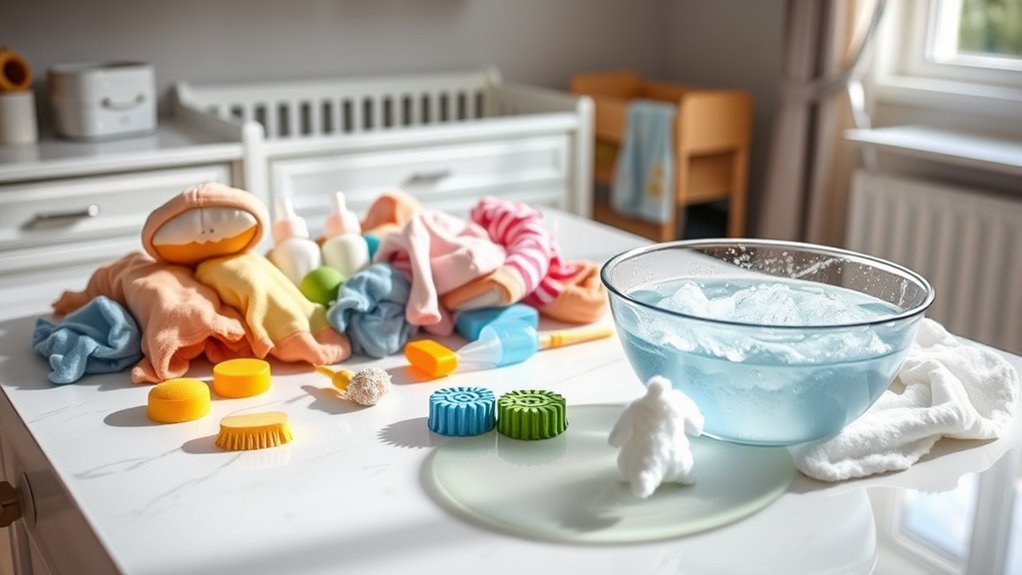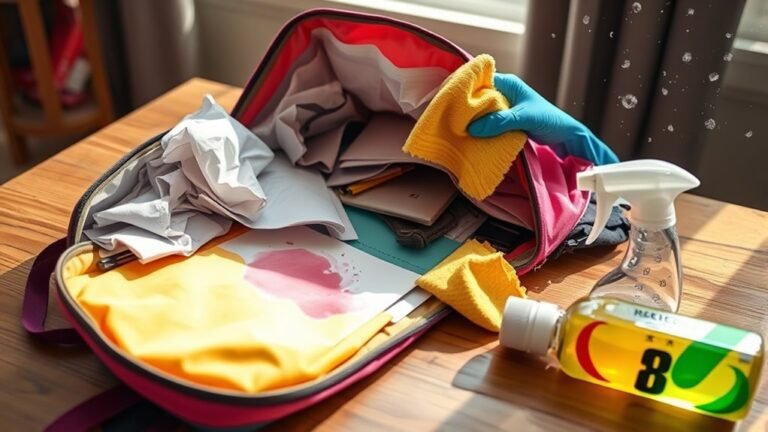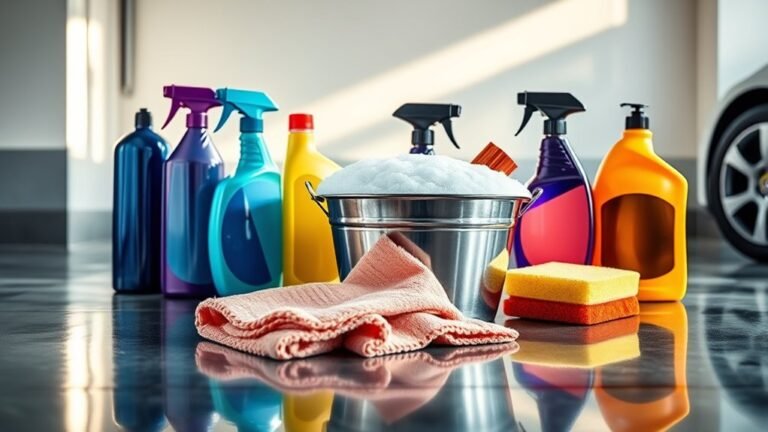Step-By-Step Guide to Cleaning Baby Items
To clean baby items effectively, start by rinsing bottles and nipples immediately, then scrub with a bottle brush and sterilize by boiling. Sanitize pacifiers and teething toys daily by boiling or soaking in a mild vinegar solution. Wash soft toys according to care labels, using gentle detergent and air-dry thoroughly. Disinfect high chairs and feeding accessories with baby-safe wipes, then dry and store everything in clean, airtight containers. Follow these essentials closely to keep your baby’s items safe and hygienic—there’s more detail to help you master each step.
Cleaning Baby Bottles and Nipples

Although it might seem straightforward, cleaning baby bottles and nipples requires careful attention to confirm all milk residue and bacteria are fully removed. You’ll want to rinse each part immediately after use to prevent buildup. Use bottle brushes designed specifically for baby bottles to reach all corners and crevices effectively. Don’t forget to clean the nipples thoroughly, as milk can get trapped inside. Once cleaned, apply proper sterilizing techniques to eradicate any lingering germs. Boiling the bottles and nipples for five minutes or using an electric steam sterilizer are reliable methods. These steps confirm your baby’s feeding equipment remains safe and hygienic. By mastering this process, you gain the freedom to focus on what matters most—your baby’s health and happiness.
Sanitizing Pacifiers and Teething Toys
Sanitizing pacifiers and teething toys at least once a day is crucial to keep your baby safe from harmful germs. You want to use safe methods that effectively kill bacteria without exposing your little one to harsh chemicals. One reliable approach is boiling these items in water for five minutes, which is a simple, natural way to sanitize. Alternatively, you can prepare homemade solutions using a mild vinegar-water mix (one part vinegar to four parts water) to soak toys for a few minutes before rinsing thoroughly. Avoid using bleach or strong disinfectants, as they can leave harmful residues. Regularly inspecting pacifiers and teething toys for damage is also important—replace them if cracks appear to prevent bacteria buildup and guarantee your baby’s health and freedom to explore safely.
Washing Soft Toys and Fabric Items

When you’re caring for your baby, keeping soft toys and fabric items clean is essential to prevent the buildup of dirt, germs, and allergens. Start by checking the care labels on each item, since soft toy materials vary widely and require different handling. Machine-wash sturdy fabrics on a gentle cycle with mild detergent, but for delicate or stuffed toys, spot-cleaning or hand-washing is safer to maintain their shape. Avoid harsh chemicals that can damage fabric fibers or irritate your baby’s skin. After washing, air-dry fabric items thoroughly to prevent mold growth. Regularly inspecting and cleaning these items not only extends their lifespan but also guarantees your baby’s environment stays hygienic and safe. Prioritize fabric care tailored to each item’s material for the best results.
Disinfecting High Chairs and Feeding Accessories
Since your baby spends a lot of time in their high chair and uses various feeding accessories daily, keeping these items disinfected is essential to prevent the spread of germs and bacteria. Start by identifying the high chair materials—plastic, metal, or wood—to choose appropriate disinfectants that won’t cause damage. Use a mild, baby-safe disinfectant spray or wipes, ensuring you cover all surfaces, especially crevices where food particles hide. For feeding utensils, prioritize feeding utensil safety by selecting BPA-free, dishwasher-safe items whenever possible. Clean utensils thoroughly with hot, soapy water before disinfecting. Avoid harsh chemicals that could leave residues harmful to your baby. Regularly disinfecting these items not only protects your child’s health but also gives you peace of mind, letting you focus on enjoying mealtime freedom together.
Proper Drying and Storage Techniques

After thoroughly disinfecting your baby’s high chair and feeding accessories, ensuring they dry properly is just as important to maintain their cleanliness. Use effective drying techniques like air drying on a clean towel or drying rack to prevent moisture buildup, which can harbor bacteria. Avoid using cloth towels that might leave fibers behind or reintroduce germs. Once completely dry, choose storage solutions that keep items dust-free and easily accessible. Airtight containers or sealed bins work well for feeding accessories, while a designated clean shelf or cupboard can store larger items like high chair trays. Proper drying and storage not only extend the life of your baby’s items but also give you peace of mind, letting you focus on what really matters—your child’s comfort and safety.
Frequently Asked Questions
How Often Should I Clean Baby Items to Prevent Illness?
You should maintain a regular cleaning frequency for baby items to guarantee effective illness prevention. Toys, bottles, and pacifiers need daily cleaning, especially when they touch your baby’s mouth. Items like crib sheets and blankets should be washed weekly. Keeping a consistent routine helps reduce germs and keeps your baby healthy without feeling restricted. Staying proactive with cleaning gives you the freedom to enjoy quality time without worry.
Can I Use Natural Cleaning Products for Baby Items Safely?
Imagine scrubbing away with chemicals so harsh they could strip paint off walls—it’s tempting to avoid that with baby items. You can absolutely use natural ingredients like vinegar, baking soda, or gentle plant-based soaps for baby safety. These options clean effectively without exposing your little one to toxic residues. Just make sure the products are free from harsh additives, and always rinse thoroughly. This way, you keep things safe, clean, and free—just like you want.
What Should I Avoid When Cleaning Baby Items to Prevent Damage?
When cleaning baby items, you should avoid harsh chemicals that can irritate your little one’s sensitive skin or damage delicate materials. Steer clear of fabric softeners too—they often leave residues that reduce absorbency and might cause allergic reactions. Instead, choose gentle, baby-safe detergents and rinse thoroughly. This way, you keep baby items clean, safe, and in good condition, giving you peace of mind and freedom from worry.
How Do I Clean Baby Items While Traveling or on the Go?
When you’re on the go, travel cleaning baby items efficiently is key. Pack portable solutions like disinfectant wipes, a small spray bottle with baby-safe cleaner, and a microfiber cloth. These let you quickly clean bottles, toys, and pacifiers wherever you are. Choose compact, easy-to-carry items that don’t add bulk but provide thorough cleaning. This way, you maintain hygiene without sacrificing your freedom to explore and enjoy your journey with ease.
Are There Specific Cleaning Methods for Newborn Versus Older Baby Items?
Yes, you’ll want to clean newborn gear more gently since their immune systems are delicate. Use mild, fragrance-free soaps and sterilize items like bottles and pacifiers regularly. For older toys, you can be a bit more flexible—washing with warm, soapy water or even using the dishwasher if safe. Always check labels, but overall, newborn gear needs extra care to keep germs away, while older toys can handle a bit more routine cleaning freedom.






